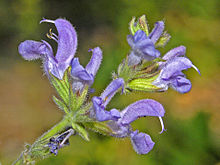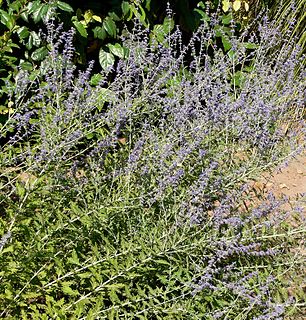
Salvia subgenus Perovskia is a group of species within the flowering plant genus Salvia, which prior 2017 were treated as the separate genus Perovskia. Members of the group are native to southwestern and central Asia. It includes the garden plant Russian sage.

Salvia mellifera is a small, highly aromatic, evergreen shrub of the genus Salvia native to California, and Baja California, Mexico. It is common in the coastal sage scrub of Southern California and northern Baja California. Black sage has a dark appearance, especially during drought.

Salvia apiana, the white sage, bee sage, or sacred sage is an evergreen perennial shrub that is native to the southwestern United States and northwestern Mexico, found mainly in the coastal sage scrub habitat of Southern California and Baja California, on the western edges of the Mojave and Sonoran deserts.

Salvia splendens, the scarlet sage, is a tender herbaceous perennial plant native to Brazil, growing at 2,000 to 3,000 m elevation where it is warm year-round and with high humidity. The wild form, rarely seen in cultivation, reaches 1.3 m (4.3 ft) tall. Smaller cultivars are very popular as bedding plants, seen in shopping malls and public gardens all over the world.

Salvia lyrata, is a herbaceous perennial in the family Lamiaceae that is native to the United States, from Connecticut west to Missouri, and in the south from Florida west to Texas. It was described and named by Carl Linnaeus in 1753.

Leucophyllum frutescens is an evergreen shrub in the figwort family, Scrophulariaceae, native to the state of Texas in the southwestern United States and the states of Coahuila, Nuevo León, and Tamaulipas in northern Mexico. Although commonly known as Texas sage, it is not a true sage and is distinct from the genus Salvia. The species is also called Texas Ranger, Texas rain sage, cenizo, Texas silverleaf, Texas barometerbush, ash-bush, wild lilac, purple sage, senisa, cenicilla, palo cenizo, or hierba del cenizo.
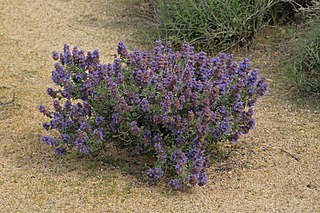
Salvia dorrii, the purple sage, Dorr's sage, fleshy sage, mint sage, or tobacco sage, is a perennial spreading shrub in the family Lamiaceae. It is native to mountain areas in the western United States and northwestern Arizona, found mainly in the Great Basin and southward to the Mojave Desert, growing in dry, well draining soils.

Salvia coccinea, the blood sage, scarlet sage, Texas sage, or tropical sage, is a herbaceous perennial in the family Lamiaceae that is widespread throughout the Southeastern United States, Mexico, Central America, the Caribbean, and northern South America. At one time Brazil was considered to be where it originated, but its diploid chromosome count now points to Mexico as its place of origin.
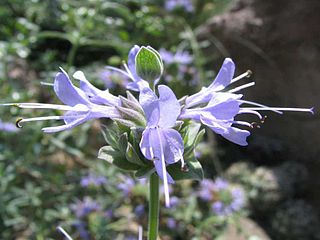
Salvia clevelandii, the fragrant sage, blue sage, Jim sage and Cleveland sage, is a perennial plant that is native to Southern California and northern Baja California, growing below 900 m (3,000 ft) elevation in California coastal sage and chaparral habitat. The plant was named in 1874 by Asa Gray, honoring plant collector Daniel Cleveland.
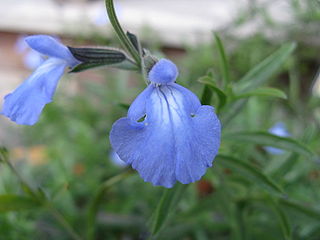
Salvia azurea, the azure blue sage, azure sage, blue sage or prairie sage, is a herbaceous perennial in the genus Salvia that is native to Central and Eastern North America.
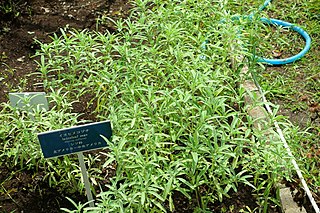
Salvia reflexa, the lanceleaf sage, Rocky Mountain sage, blue sage, lambsleaf sage, sage mint or mintweed, is a perennial subshrub native to the United States and Mexico and introduced to Argentina, Australia, Canada, South Africa and New Zealand.
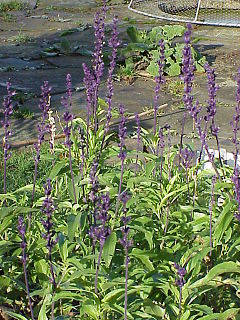
Salvia farinacea, the mealycup sage, or mealy sage, is a herbaceous perennial native to Nuevo León, Mexico and parts of the United States including Texas and Oklahoma. Violet-blue spikes rest on a compact plant of typically narrow salvia-like leaves; however, the shiny leaves are what set this species apart from most other Salvia, which bear velvety-dull leaves.

Salvia hierosolymitana is a species of flowering plant in the family Lamiaceae. It is a herbaceous perennial commonly called Jerusalem salvia or Jerusalem sage that is native to the eastern Mediterranean, with populations in Cyprus, Israel, Jordan, Lebanon, Syria, and the West Bank. It typically grows in open fields, rocky soils, and among low-growing native shrubs. It was first described in 1853 by botanist Pierre Edmond Boissier, with the epithet "hierosolymitana" referring to "royal, sacred Jerusalem".
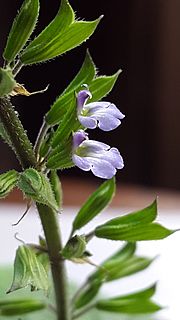
Salvia tiliifolia is a vigorous, herbaceous annual in the family Lamiaceae that is native to Central America. As a pioneer of abused areas, the plant has spread in modern times into: South America, as far south as Peru and Bolivia; the southwestern regions of the United States, including the states Texas and Arizona; Africa, including South Africa and Ethiopia; China, including the provinces of Yunnan and Sichuan.

Salvia occidentalis is a small annual herb native to the Caribbean, Mexico, and South America

Salvia urticifolia is a herbaceous perennial native to the southeastern United States. S. urticifolia is an erect plant that reaches 20 to 70 cm tall. Flowers, with a corolla that is approximately 1.2 cm (0.47 in) long, are blue or purple, growing in panicles on short pedicels. The lower lip has three lobes, with a pair of white marks coming from the throat. The leaves are crenate—similar to the leaves of Urtica species.
Salvia engelmannii is a herbaceous perennial that is endemic to the limestone hills of central Texas. Salvia engelmannii forms a mound 1 to 1.5 ft tall with velvety leaves. The flowers are pale lavender, growing on 4 to 6 in spikes.
Salvia henryi, the crimson sage, is a herbaceous perennial that is native to the U.S. states of Texas, New Mexico, and Nevada, and northern Mexico. It is frequently found growing on rocky slopes and in canyons, along with piñon and juniper. The gray leaves are covered with soft hairs, with bright red bilaterally symmetrical flowers growing in pairs.
Salvia leptophylla is a herbaceous perennial that is native to Texas. As the common name implies, it has slender leaves and stems that give the plant an airy look, reaching 2 ft (0.61 m) tall with ensign blue flowers.
Salvia whitehousei, the clustered sage, is a herbaceous perennial that is native to Texas.
